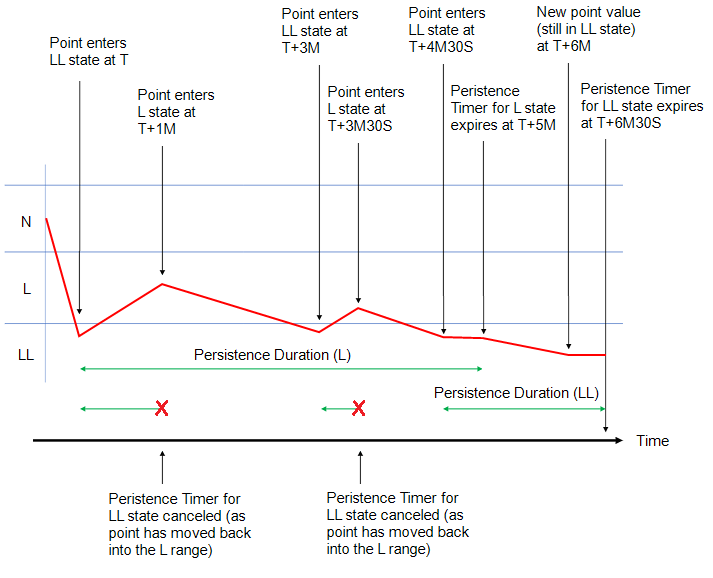Examples of Persistence with an Analog Point
These examples demonstrate how persistence might be used on an analog point on the DNP3 driver. Additionally, the second part of the Out of State Persistence example illustrates how Significant Change settings affect when the point’s change in value is recorded. For more information about Significant Change, see Define the Criteria for a Significant Change in Value.
Example 1 - Into State Persistence:
An analog point has this configuration:
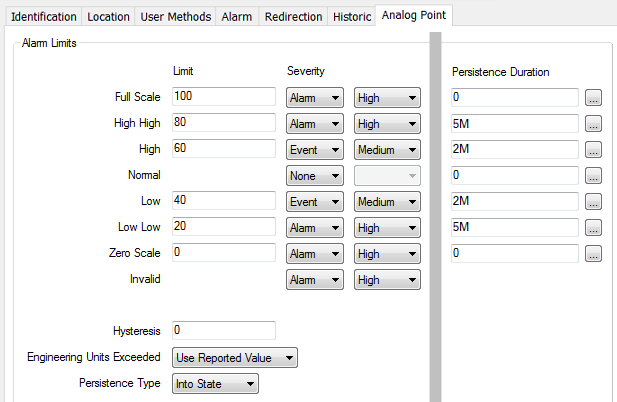
The relevant persistence time begins whenever the analog point’s value crosses a state limit.
The analog point changes value from 50 (Normal state) to 35. A period of 2 minutes has to elapse before the point value and point state (Low) are deemed to have changed and are recorded. This is because the Persistence Duration for the point going into the Low state is specified as 2M (2 minutes).
(If, during this 2-minute period, the point’s value rises back above 40 (back into the Normal state), no change in point value or state is recorded, as the point is deemed not to have changed.)
If, during the 2-minute period, the point’s value does not rise, but instead it continues to fall, if it drops below 20 (the Low Low limit), the persistence timer restarts. A period of 5 minutes will then have to elapse before the point value and state (Low Low) are deemed to have changed and are recorded. This is because the Persistence Duration for the point going into the Low Low state is specified as 5M (5 minutes).
Example 2 - Out of State Persistence:
An analog point has this configuration:
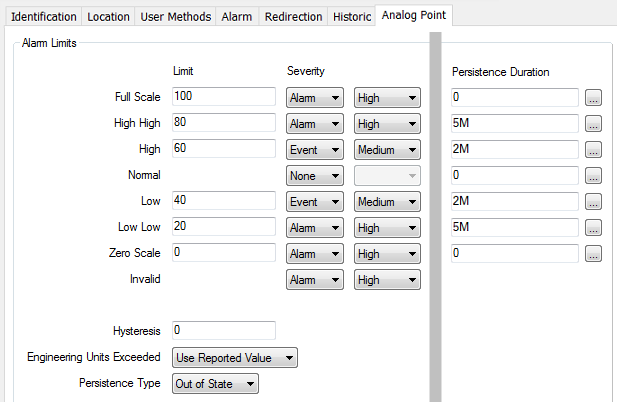
The relevant persistence time begins whenever the analog point’s value crosses a state limit.
The analog point changes value from 50 (Normal state) to 35. As the Normal state’s Persistence Duration is zero, the change in point value and point state (Low) are recorded immediately.
The point’s value continues to fall. The value drops below 20, triggering the Out of State Persistence Duration for the Low limit. This is triggered as soon as the point moves out of the Low state into another state. A period of 2 minutes then has to elapse before the point value and point state (Low Low) are deemed to have changed and are recorded. This is because the Persistence Duration for the point going out of the Low state is specified as 2M (2 minutes).
(If, during this 2-minute period, the point’s value changes further, rising above 20, back into the Low state, the fleeting change in point value and state (to Low Low) are not recorded, as the point is deemed not to have changed from the Low state.)
If the point’s value continues to rise, once it travels out of the Low state again, it triggers the Out of State Persistence Duration for that state. It the point remains out of the Low state for the entire 2-minute duration, its new state and value are recorded when that duration elapses. So, if after 2 minutes the point’s value is 75, this value, along with its new state (High) are recorded.
If the point uses these Significant Change settings, along with a Persistence Type of ‘Out of State’:

If the change in point value when the point moves into the Low Low state results in a value change that exceeds the Significant Change Deadband, the new value and old state (Low) are recorded immediately, due to that Deadband being exceeded. (The Deadband in this example is 5% of the point range (Zero Scale to Full Scale).) Additionally, if the point remains out of the old state (Low) for the Persistence Duration of 2M (2 minutes), once that duration elapses, the current point value (which might differ from the value that was recorded when the Significant Change Deadband was exceeded) and new state (Low Low) are recorded. However, if at any stage during the Persistence Duration, the point reverts back to a value greater than 20 (back into the Low state), the fleeting change to the Low Low state is not recorded.
Similarly, if the change in point value when the point rises out of the Low state results in a value change that exceeds the Significant Change Deadband, the new value and old state (Low) are recorded at that instant. Then when the Low state’s Out of State Persistence Duration has been exceeded, the point’s current value (75 in this example) and state (High) are recorded.
Example 3 - Away From Normal Persistence - Scenario 1:
An analog point has this configuration:
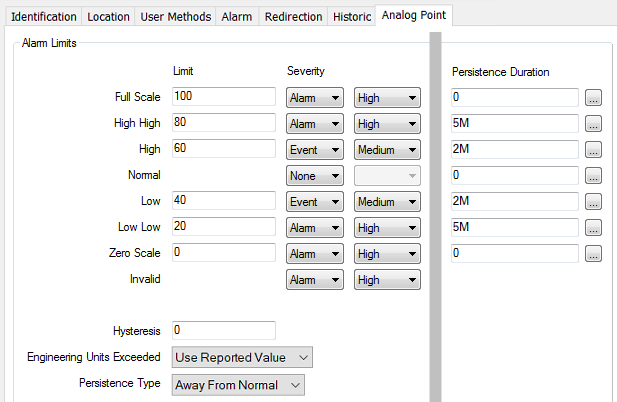
The relevant persistence time begins whenever the analog point’s value crosses a state limit, providing that the point is traveling in a direction that is going away from the Normal state.
The analog point changes value from 50 (Normal state) to 35. A period of 2 minutes has to elapse before the point value and point state (Low) are deemed to have changed and are recorded. This is because the Persistence Duration for the point going into the Low state when traveling away from the Normal state is specified as 2M (2 minutes).
(If, during this 2-minute period, the point’s value rises back above 40 (back into the Normal state), no change in point value or state is recorded, as the point is deemed not to have changed.)
If, during the 2-minute period, the point’s value continues to fall, so that it drops below 20 (into the Low Low limit), the persistence timer for the Low limit continues to run. Additionally, the persistence timer for the Low Low limit starts. (This is due to the point's value continuing to travel in a direction that is away from the Normal state, with the Persistence Type being set to 'Away From Normal'.)
Providing that the point's value does not rise above 40 during that 2-minute period, the Low limit's persistence timer will expire at the end of that time and the point value and state (Low) will be deemed to have changed and are recorded. Notice that the point's state is recorded as Low. This is the point state that will be recorded regardless of whether the point's value is within the Low or Low Low range of values when the Low limit's persistence timer expires. This is because only the Low limit's persistence timer has expired at this stage.
If the point's value does not rise above 20 (the Low Low limit) then the persistence timer for the Low Low limit will continue to run. Once that timer's Persistence Duration of 5 minutes has elapsed, the point value and state (Low Low) are deemed to have changed again and are recorded.
In the diagram below, L = Low, LL = Low Low, N = Normal state, and T = Time. At T, the point's value drops such that it enters the Low state. This triggers the Low state's persistence timer to start; this is configured with a Persistence Duration of 2M (2 minutes). After 1 minute, the point's value drops further, such that it enters the Low Low state. The persistence timer for the Low state continues to run, but additionally the persistence timer for the Low Low state starts to run. This latter state has a Persistence Duration of 5M (5 minutes). 1 minute later, at T+2M, the persistence timer expires for the Low state, at which stage the point' state is recorded as Low (as that is the timer that has expired). The point's value is still in the Low Low state 4 minutes later (at T+6m), when the Low Low state's persistence timer expires, and at that stage the driver records the point as being in the Low Low state.
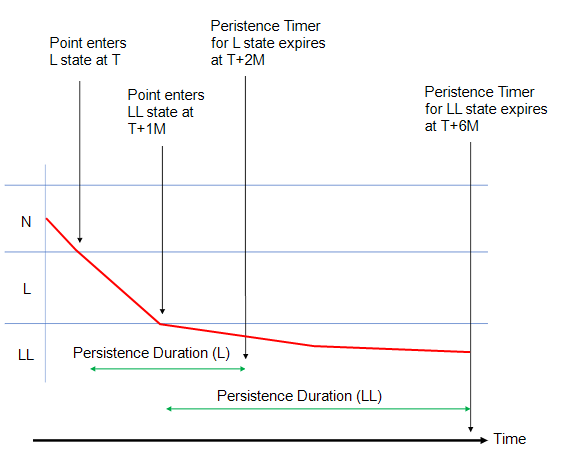
(If, during the 5-minute period, the point's value had risen back above the Low Low limit of 20, no further change in point value or state would be recorded, as the point would be deemed not to have changed.)
Swapped Persistence Durations
Consider the same analog point, but with the Persistence Duration of the two limits being swapped (so that the Low limit has a Persistence Duration of 5M, and the Low Low has a Persistence Duration of 2M).
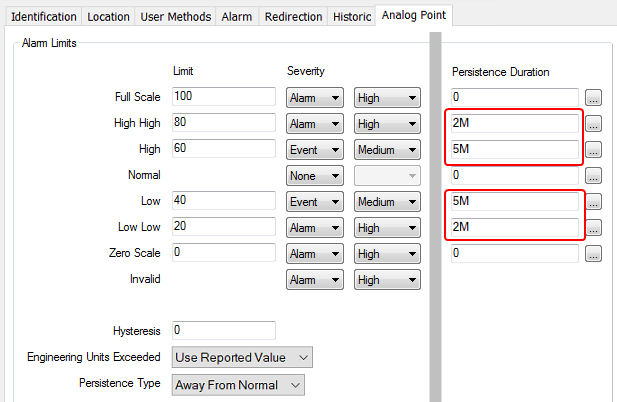
With a point value that is oscillating between Low and Low Low, when traveling away from the Normal state into the Low Low state, the Low Low timer will expire before the Low timer. This will result in a Low Low state being recorded when the point's value is within the range for the Low Low limit, without the initial recording of the Low state when value is actually in the Low Low range.
In the diagram below, L = Low, LL = Low Low, N = Normal state, and T = Time. When the point's value drops such that it enters the Low state, this triggers the Low state's persistence timer to start; this is configured with a Persistence Duration of 5M (5 minutes). After 2 minutes, the point's value drops further, such that it enters the Low Low state. The persistence timer for the Low state continues to run, but additionally the persistence timer for the Low Low state starts to run. This latter state has a Persistence Duration of 2M (2 minutes). As the point's value is still in the Low Low state 2 minutes later, when the Low Low state's persistence timer expires, the driver records the point as being in the Low Low state.
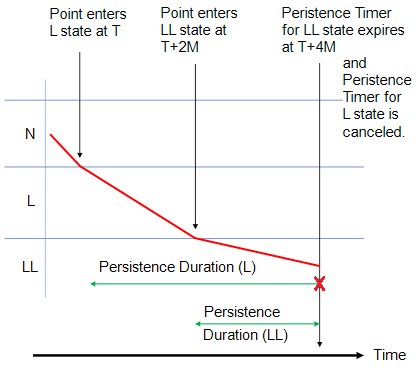
When traveling in a direction that is away from the Normal state, whenever a persistence timer expires for a limit that is further away from the Normal state than another limit, any persistence timers that are running for limit(s) that are closer to the Normal state cease automatically. (So in the diagram above, the Low persistence timer automatically ceases to run when the Low Low persistence timer expires.) This only applies when the Persistence Type is set to 'Away From Normal'.
Additionally with this Persistence Type, whenever a persistence timer expires and then the point's value travels in a direction that is towards the Normal state, and crosses a limit boundary, no persistence applies in that direction. Any changes to the point value and state are recorded as soon as the point crosses a limit boundary when traveling towards the Normal state.
Example 4 - Away From Normal Persistence - Scenario 2:
An analog point has this configuration:
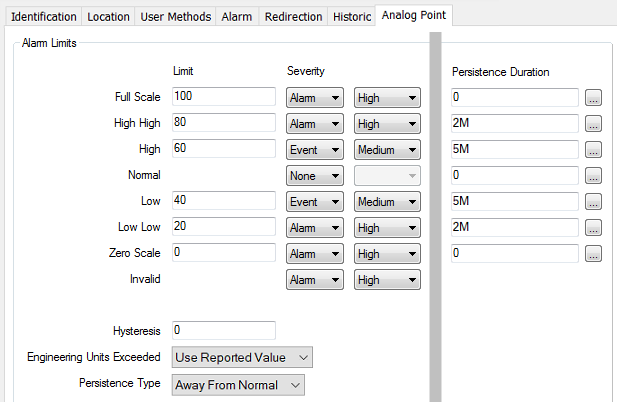
The relevant persistence time begins whenever the analog point’s value crosses a state limit, providing that the point is traveling in a direction that is going away from the Normal state.
The analog point changes value from 50 (Normal state) to 15 (which is within the Low Low range of values). This triggers two persistence timers to start running: that for the Low state, along with the timer for the Low Low state.
After 1 minute, the point value rises to 30 (which is within the Low range of values). The persistence timer for the Low state continues to run, but the persistence timer for the Low Low state is canceled.
After a further 2 minutes, the point value falls to 18 (so moves back into the Low Low range of values). The persistence timer for the Low state still continues to run, and the persistence timer for the Low Low state restarts.
After a further 30 seconds, the point value rises to 25 (so moves back into the Low range of values). The persistence timer for the Low state is still running, but the persistence timer for the Low Low state is canceled.
After a further minute, the point values falls to 15 (so moves back into the Low Low range of values). The persistence timer for the Low state continues to run, and the persistence timer for the Low Low state restarts.
30 seconds later, the persistence timer for the Low state expires. This is because the Persistence Duration for the point going into the Low state when traveling away from the Normal state is specified as 5M (5 minutes) and that duration has now expired. The point's state is recorded as Low (as it is the Low limit's persistence timer that has expired) even though the point's value is within the Low Low range. This is the point state that will be recorded regardless of whether the point's value is within the Low or Low Low range of values when the Low limit's persistence timer expires.
1 minute later, the point value falls even lower, to 10 (which is still within the Low Low range). The persistence timer for the Low Low range continues to run.
30 seconds later, the persistence timer for the Low Low state expires. This is because the Persistence Duration for the point going into the Low state when traveling away from the Normal state is specified as 2M (2 minutes) and that duration has now expired. The point's state is recorded as being in the Low Low state.
The above scenario is shown in the diagram below, in which L = Low, LL = Low Low, N = Normal state, and T = Time. This shows that the persistence timer for the Low state runs continuously until it expires, whereas the persistence timer for the Low Low state gets canceled each time that the point's value rises back into the Low range of values. The persistence timer for the Low Low state only expires once the point's value has remained continuously in the Low Low state for that state's full Persistence Duration of 2M (2 minutes).
